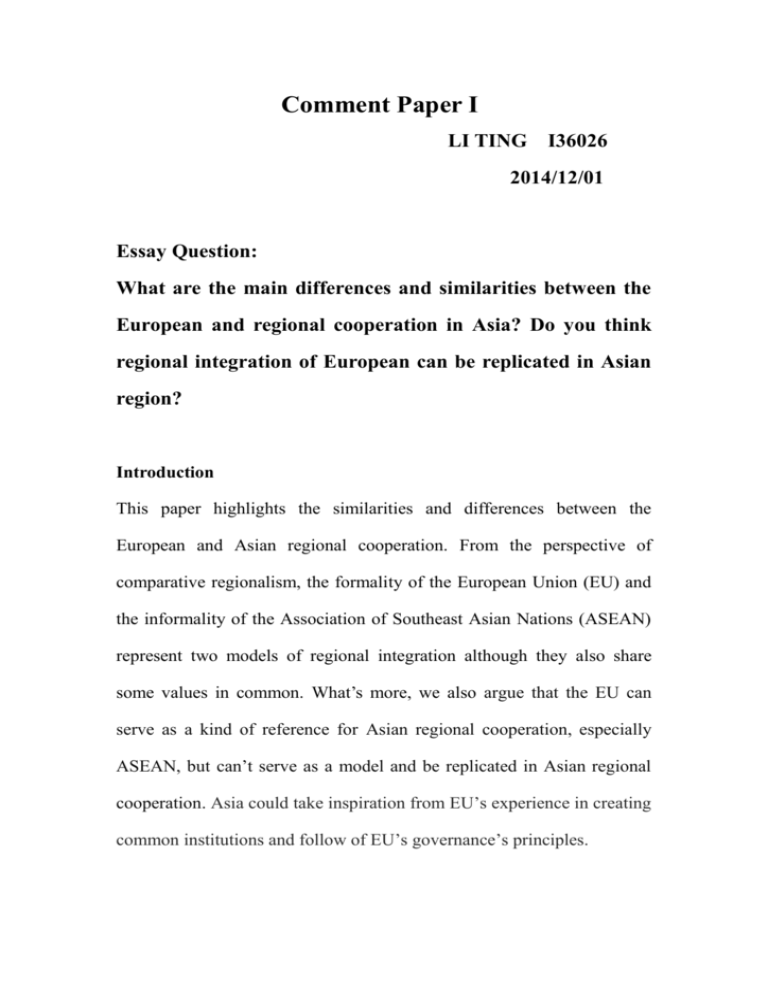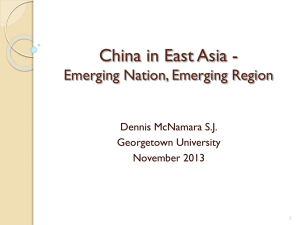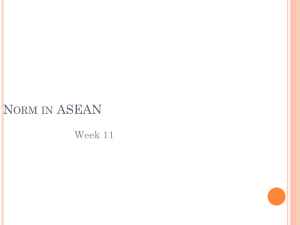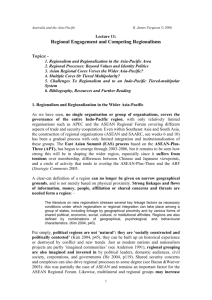EU can be replicated in Asian regional integration?
advertisement

Comment Paper I LI TING I36026 2014/12/01 Essay Question: What are the main differences and similarities between the European and regional cooperation in Asia? Do you think regional integration of European can be replicated in Asian region? Introduction This paper highlights the similarities and differences between the European and Asian regional cooperation. From the perspective of comparative regionalism, the formality of the European Union (EU) and the informality of the Association of Southeast Asian Nations (ASEAN) represent two models of regional integration although they also share some values in common. What’s more, we also argue that the EU can serve as a kind of reference for Asian regional cooperation, especially ASEAN, but can’t serve as a model and be replicated in Asian regional cooperation. Asia could take inspiration from EU’s experience in creating common institutions and follow of EU’s governance’s principles. The comparison and contrast between European and regional cooperation in Asia Triggered by different historical events, Europe by WWII and the very term “Southeast Asia” by colonialism and rising disputes and rivalry between major powers, the states in both regions chose to work together to secure peace and stability. The aims of ASEAN and EU are almost the same, or at least comparable. The pursue the peace and security of national independence against interference from external states, the economic prosperity and social security, and more and more the preservation of the national competitiveness in the age of globalization However, the fundamental background and the approaches to regional integration were totally different of those two regions. Regionalism has progressed much earlier in Europe than in Asia. European states’ decision of working together to bind their economies and societies was driven by the destruction and hardship caused by two world wars. They realized that by sharing sovereignty with regional partners in certain areas could generate much higher benefits than by acting individually. By drafting common rules, promoting close coordination among national authorities, and developing strong regional institutions that advance economic integration based on a legalistic approach to regional cooperation and encompassing the development of strong regional institutions, EU was able to generate substantial economic gains through the creation of a single market and a common currency, and by close coordination among national authorities in several economic, political, and social issues. After adopting a common trade policy, European countries agreed to the free movement of goods, labor, capital and services. In contrast, regionalism in Asia has developed rather differently. At the same time, the Asian model is the one following a much more pragmatic and flexible approach. As the postcolonial period generated many modern Asian nations, regionalism and the idea of sovereignty was not the priority for the regional cooperation. Regional cooperation was to be built by an ‘ASEAN WAY’ based on consultation, consensual decision-making, and flexibility. Rather than starting with ambitious political commitments, ASEAN would process by small, informal, and voluntary steps, which could eventually become more binding and institutionalized. In Asia are market forces more than governments that have shaped regional economic integration. Treaties are usually short and meant to formalize informal interactions among members rather than introducing a complex set of binding rules and related sanctions like it was in Europe. The triggering factor for enhancing regional cooperation in Asia during the past decades was the 1997-1998 financial crisis, which also led to a new format of cooperation with China, Japan, and South Korea as ‘ASEAN PLUS Three’ (APT), seen by some as the realization of the idea of underlying the East Asian Economic Caucus. Asia lacks strong regional institutions and a bureaucratic body to serve the region. Asia’s few regional institutions are small and lean, with a limited mandate from national authorities to manage external shocks, internalize regional spillovers, and provide effective regional public goods. European regionalism is dominated by the EU, while Asian regionalism is based on many overlapping sub regional organizations that cooperate to varying degrees in different areas and provide a solid backbone to connect markets and people. Aside from these differences, the most critical distinction between the EU and ASEAN is their regard for sovereignty. For Europe, the reduction of national sovereignty is necessary for integration, but for ASEAN the preservation of national sovereignty is the thrust behind its regionalism. Since most Asian countries have just achieved their independence from colonialism in the last decades of the last century, they consider sovereignty as vital and non-negotiable. Because of this, ASEAN remains largely intergovernmental. EU can be replicated in Asian regional integration? Asia can learn from the EU’s successful experience in the principles for governance like the combination of majority ruling and decisions that require consensus among all members, depending on the issue. Also, Asia could be inspired by the proactive approach Europe applied in creating common institutions, which Asia lacks of establishing strong institutions for regional cooperation. The regional integration, somehow, implies the loss of state sovereignty, which is evident in EU. It works on a formal system of supranational institutions with the methods of decision-making, resulting in a more politically and economically integrated region. However, the Asian regionalism like ASEAN operates on the principle of open regionalism, which does not require the loss of sovereignty. Following the principles of mutual respect, non-interference, and peaceful settlement of differences, ASEAN’s intergovernmental structure functions with less regulated systems and institutions, based on a consensus-based approach to decision making. ASEAN member states seek to be flexible enough to align their national interests towards a shared compromise in order to make the organization more effective and relevant. As the Singaporean diplomat Tommy Koh put it, the EU is an “inspiration, but not a model” for ASEAN. The implication here is that while EU has demonstrated the successful experience for the states to overcome a history of internecine warfare and divergent national interests through socialization, and also that is inspirational for Asia, the EU model of cooperation is so different and specific that cannot be replicated in Asia. Asian regional cooperation is unique and is following its own way to pursue a more diverse and its acquisition of full sovereignty in the aspects of culture, economy and politics. Conclusion In summary, by comparing the EU and Asian regional cooperation, especially ASEAN, we try to argue that regional development between those two regions have different patterns and models, which cannot be replicated but can be kind of reference for the regional cooperation. References Acharya, A. (2006) “Europe and Asia: Reflections on a Tale of Two Regionalisms,” in Fort, B./Webber, B. (eds), Regional Integration in East Asia and Europe: Convergence or Divergence? London and New York: Routledge. Amitav Acharya, “Regionalism and Integration: EU and Southeast Asian Experiences”, International Culture Dialogue, Bertelsmann Stiftung. Katinka Barysch, “A New Reality for the European Union” CFR Working Paper (2010) Koh, Tommy (2008) ‘Not perfect but Charter is good start on road to regional progress: response to Barry Desker’s criticism of ASEAN Charter’, Straits Times, 21 July. Lindberg, Lena, A status report on the ASEAN and EU Economic integration in 2007, Singapore 2007 Wong, Andrea Chloe, 2014: The EU and ASEAN: Prospects for Inter-Regional Coope- ration. NFG Policy Paper Series, No. 03, January 2014








